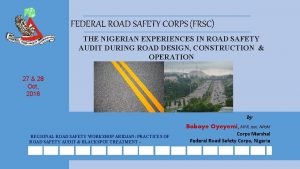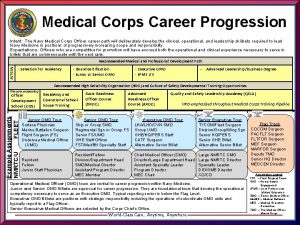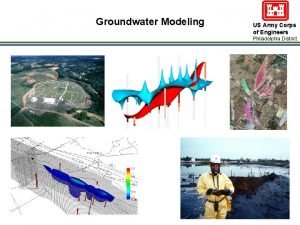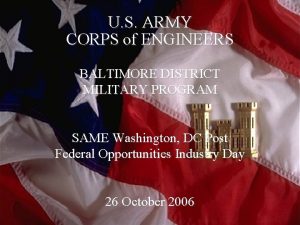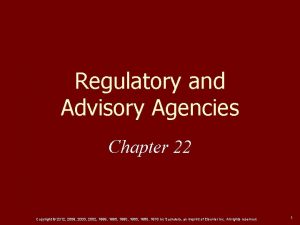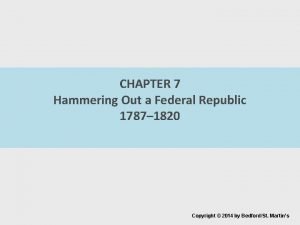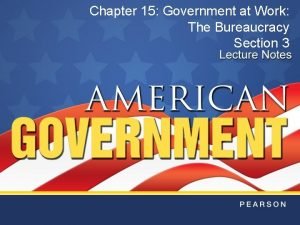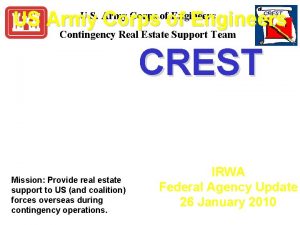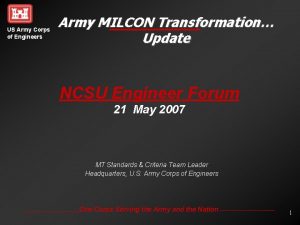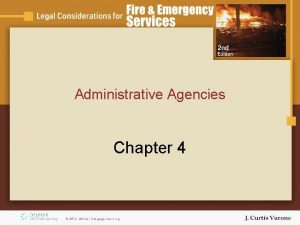Chapter 9 Federal Water Agencies US Army Corps




















- Slides: 20

Chapter 9. Federal Water Agencies • • • US Army Corps of Engineers, ACE US Bureau of Reclamation, USBR US Geological Survey, USGS US Fish and Wildlife Services, FWS US National Park Service, NPS US Bureau of Land Management, BLM US Environmental Protection Agency, EPA US Natural Resources Conservation Service, NRCS US Forest Service, USFS Federal Energy Regulatory Commission, FERC National Marine Fisheries Service, NMFS Federal Emergency Management Agency, FEMA


US Army Corps of Engineers (ACE) • Founded in 1794 • Early history in removing snags and building levees on the Mississippi – Average lifespan of a steamboat in 1800 s was less than two years • Until 1930 s primary activity was flood control and navigation in Eastern US – Most navigable rivers are in the East – 230 locks • Great Mississippi River Flood of 1927 stimulated federal role in flood control – Peak discharge of 2. 5 million cfs – 200 people killed and 600, 000 left homeless – Flood Control Acts of 1928 and 1936 – 1936 law required cost-benefit analysis

Mississippi Flood 1927 https: //www. youtube. com/watch? v=MGs 2 i. Lo. DUYE


ACE: Dams • Federal government began large western dam-building program during Great Depression – Hoover Dam completed in 1935 – Part of purpose was to provide employment • ACE began to compete with Bureau of Reclamation (USBR) for western dam projects – Primary purpose was irrigation – Flood control and navigation was secondary • Example is Garrison Dam on the Missouri River in North Dakota – USBR had determined that it was uneconomical – Dam would inundate Fort Berthold Indian Reservation land – ACE redid cost-benefit analysis and lobbied Congress to approve project – Approved in 1944 for construction by ACE


ACE: Wetlands • Early federal laws encouraged draining of swamps for navigation and disease control – Swamp Lands Act of 1850 and 1860 • Clean Water Act Amendments 1972 provided protection of wetlands (swamps) – Section 404 required ACE approval of any development that would alter or destroy a wetland

John Wesley Powell (1834 -1902) • Lost an arm in the Civil War Battle of Shiloh • First to survive a float trip down the Colorado River through the Grand Canyon • Second director of the US Geological Survey • Promoted federal role in irrigation projects • Cautioned that allowing inter-basin transfers of water would leave some basins without water • Thought state lines should be drawn along watershed divides to avoid water disputes

US Bureau of Reclamation • Founded by Reclamation Act of 1902 – Purpose to provide water to promote settlement of arid western states – Irrigation water initially limited to farms < 160 acres – Construction costs to be repaid by farmers – Local irrigation districts set up to control finances – Early success in making small projects pay • Later large projects catered to corporate farms and special interests – Acre limits were ignored, and local districts did not collect finances – Hoover Dam in 1935 and Grand Coulee Dam in 1941


US Bureau of Reclamation • 1960 s to 1970 s heyday of dam building – USBR (and ACE) allied with strong Congressional committee leaders and agricultural/corporate special interest groups – Obtained federal funding for western irrigation projects with questionable cost-benefit analysis – Often in direct conflict with Presidents’ wishes • Anti-dam era began in 1970 s – Ralph Nader’s Damming the West critical of USBR – Teton Dam failure in eastern Idaho in 1976 • President Jimmy Carter recommend eliminating funding for 18 USBR dam projects • Endangered Species Act passed in 1973 – Snail darter vs. Tellico dam in 1978 -79 • New mission to manage existing water projects and promote conservation

US Environmental Protection Agency • Water Quality Act of 1965 – Created first water quality standards with limited success • US EPA created in 1970 – Legislative authority to impose fines and jail sentences for violation of environmental laws – Filed suit against Detroit, Cleveland, and Atlanta • Clean Water Act Amendments of 1972 – Goal of making all waters “fishable and swimmable” by 1983 – Strengthened federal water quality standards – Established permit system for point sources (National Pollutant Discharge Elimination System, NPDES) – Over $20 billion spent on municipal sewage plants 1972 -1992 – Section 404 protected wetlands – TMDL program for regulating Point and Nonpoint Sources

Jimmy Carter • Jimmy Carter’s first experience with dams was as Governor in Georgia – Carter had a degree in Nuclear Engineering from US Naval Academy • Dam was proposed for Sprewell Bluff on the Flint River in Georgia by ACE (now a park in Upson County) – Carter read the plan and wrote blistering 18 -page letter to ACE accusing it of “computational manipulation” – Vetoed plans for the dam • Shortly after election as President in 1976 Carter reviewed federal program to manage water resources – 19 new water projects were proposed by USBR and ACE – Concluded “There is no coherent water resources management policy” – Carter vetoed a bill to fund the projects

Snail Darter vs. Tellico Dam Conflict described in Marc Reisner’s Cadillac Dessert and Chapter 12 of textbook

Tennessee Valley Authority • Created during the Great Depression by President Franklin Roosevelt – “A corporation clothed with the power of government but possessed of the flexibility and initiative of a private enterprise” • First attempt at “watershed approach” to planning • Goal was to aid development in poor rural areas by providing cheap electricity, fertilizers, etc. • Did this by developing hydroelectric dams – www. tva. gov/sites_ie 2. htm • TVA started out with a good approach but then outgrew its mission (in Reisner’s view)

Snail Darter vs. Tellico Dam • By 1970 s much of the TVA electric power was being generated by coal-powered plants – Strip mining coal was destroying the land – Coal-powered plants were contributing to acid rain and mercury problems throughout the Eastern US – Much of the area was still poverty-stricken • Tellico Dam was proposed by TVA in 1960 s – Dam would not produce hydropower – Would raise the level in the Little Tennessee River so that extra water could be run through a canal to an existing hydroelectric dam – Would produce relatively insignificant additional power – No flood control benefit – Little recreational benefit (many other reservoirs in surrounding area) – Approved for construction in 1969

• Endangered Species Act passed in 1973 – In 1973, Professor of Zoology from University of Tennessee discovered a unique snail darter in the Little Tennessee River – 1975 FWS classified snail darter as an endangered species – Court ordered dam construction halted – Decision upheld by Supreme Court in 1978 • Congress began considering amendments to ESA that would allow construction of Tellico Dam – Passed a law that set up a Cabinet-level committee that would resolve any case where ESA stopped construction of a dam – Composed of Secretaries of Interior, Agriculture, Army, EPA and others – Called the “God Squad”

• In 1978 God Squad reviewed case – Unanimously decided against dam construction – Based decision on economics, not environmental impact – Cost-benefit analysis was faulty and did not justify construction • June 1979 Congress approved a little-noticed amendment to House appropriations bill – Exempted Tellico Dam from ESA – Congress approved appropriations bill • Carter could veto bill – Needed Congressional support for treaty that would return Panama Canal to Panama – Couldn’t afford to alienate key congressmen • Tellico Dam was completed in 1980 • 1984 FWS downgraded snail darter from endangered to threatened

Chapter 9 Summary • Principal federal agencies dealing with water resources are – Army Corps of Engineers – Bureau of Reclamation – Environmental Protection Agency • Historical trend has been toward greater federal involvement • Water resources development in the west has tended to benefit special interest groups • Recent focus is on environment and conservation
 Water and water and water water
Water and water and water water Universal precautions milady
Universal precautions milady Frsc vision and mission statement
Frsc vision and mission statement Navy supply officer career path
Navy supply officer career path Hec-ras download army
Hec-ras download army Us army corps of engineers philadelphia district
Us army corps of engineers philadelphia district Army corps of engineers baltimore
Army corps of engineers baltimore Combined arms training strategies
Combined arms training strategies Chapter 22 regulatory and advisory agencies
Chapter 22 regulatory and advisory agencies Dea number verification
Dea number verification Introduction to health care agencies
Introduction to health care agencies A paved blacktop parking lot was built
A paved blacktop parking lot was built Chapter 15 the federal bureaucracy
Chapter 15 the federal bureaucracy Chapter 13 federal and state court systems
Chapter 13 federal and state court systems The federal court system chapter 11 answer key
The federal court system chapter 11 answer key Chapter 7 federal income tax
Chapter 7 federal income tax Hammering out a federal republic
Hammering out a federal republic Which trend characterized thomas jefferson's presidency?
Which trend characterized thomas jefferson's presidency? Chapter 15 section 1 the federal bureaucracy answer key
Chapter 15 section 1 the federal bureaucracy answer key Chapter 15 government at work the bureaucracy
Chapter 15 government at work the bureaucracy Kasturba memorial fund aims and objectives
Kasturba memorial fund aims and objectives


